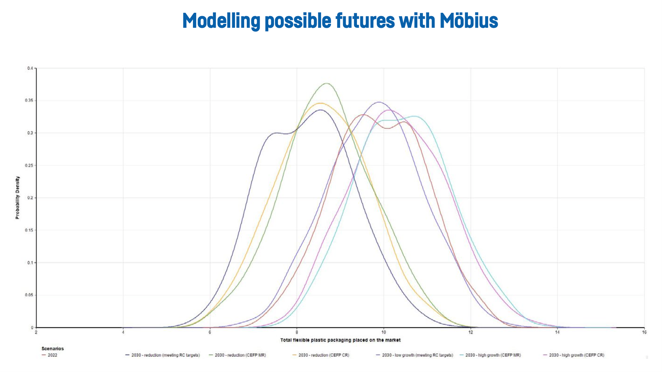What will the flexible packaging value chain need to look like by 2030 to meet recycled content and recycling rate targets required in European legislation and deliver the circular economy?
To answer this question, and others, CEFLEX has developed a new model – called Möbius – designed to bring greater understanding of the material flows and infrastructure required to develop the circular economy for flexible plastics.
It builds on a long-standing collaboration with the University of Gent, assessments of sustainable end markets, CEFLEX’s ‘Quality Recycling Process’ project data and our analysis of chemical recycling yields and feedstocks – plus expert input to investigate potential scenarios and explore different choices and their implications.
Ultimately, it is helping businesses and beyond refine their understanding and better identify the actions needed to deliver on EU legislative targets and exceed them in the future.
MÖBIUS – a new phase stepping up CEFLEX’s modelling work
Möbius works with an extensive set of assumptions based on data and expert judgement, which makes it a continuous work in progress – but it has already proven instrumental in evaluating different scenarios for the recycling of flexible plastic packaging in Europe. Future modelling prospects for Möbius include incorporating other sources of plastic waste, new recycling technologies and price effects.
 CEFLEX also uses Möbius to support our collection , sorting and recycling strategy recommendations among other pieces of work.
CEFLEX also uses Möbius to support our collection , sorting and recycling strategy recommendations among other pieces of work.
By exploring a number of different combinations of technologies and capacity choices required we can assess and inform industry of the implications of delivering on recycled content and recycling targets in PPWR legislation.
Bringing this together, it provides a solid basis for engaging the wider value-chain, other material sectors and decision-makers with data-supported insights within feasible established boundaries.

Assumptions and data fuelling Möbius
 To explore Packaging and Packaging Waste Regulation (PPWR) and circular economy targets, Möbius has been designed as a probability model. It uses a range of feasible distributions for the same variable based on available data from industry and academia.
To explore Packaging and Packaging Waste Regulation (PPWR) and circular economy targets, Möbius has been designed as a probability model. It uses a range of feasible distributions for the same variable based on available data from industry and academia.
Nearly 80 different assumptions were used in the Möbius model. In compiling and applying them, we acknowledge some of the uncertainty around key indicators, such as material returned to the market, and the model uses ranges to reflect this uncertainty. The Monte Carlo analysis approach was used to combine the ranges; a recognised and established statistical method of working with uncertainty.
CEFLEX stakeholders at the fore
Participating organisations in CEFLEX have been key to evolving and sense-checking the modelling work as well as having priviledged access to its conclusions and results.
Although a continual work in progress, MÖBIUS has given several sessions through our general meetings, work package sessions and ad-hoc webinars.
If you are not yet a stakeholder – and wish to discover more about the the interconnections and implications of different scenarios for achieving EU legislative targets and beyond, then contact us a info@ceflex.eu
